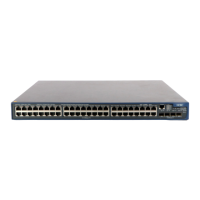Operation Manual – Routing Protocol
H3C S3600 Series Ethernet Switches-Release 1510 Chapter 4
OSPF Configuration
4-2
4.1.2 OSPF Route Calculation
Taking no account of area partition, the routing calculation process of the OSPF
protocol is as follows:
z Each OSPF-capable router maintains a link state database (LSDB), which
describes the topology of the whole AS. According to the network topology
around itself, each router generates a link state advertisement (LSA). Routers on
the network exchange LSAs with each other by transmitting protocol packets.
Thus, each router receives the LSAs of other routers and all these LSAs form the
LSDB of the router.
z An LSA describes the network topology around a router, whereas an LSDB
describes the network topology of the whole network. Routers can easily
transform the LSDB to a weighted directed map, which actually reflects the
topology of the whole network. Obviously, all routers get exactly the same map.
z A router uses the shortest path first (SPF) algorithm to calculate the shortest path
tree with itself as the root. The tree shows the routes to the nodes in the
autonomous system. External routes are leaf nodes, which are marked with the
routers from which they are advertised to record information outside the AS.
Obviously, the routing tables obtained by different routers are different.
Furthermore, to enable individual routers to broadcast their local status information
(such as available interface information and reachable neighbor information) to the
whole AS, routers in the AS should establish neighboring relationship among them. In
this case, the route changes on any router will result in multiple transmissions, which
are unnecessary and waste the precious bandwidth resources. To solve this problem,
designated router (DR) and backup designated router (BDR) are defined in OSPF. For
details about DR and BDR, see section
4.1.4 III. "DR and BDR".
OSPF supports interface-based packet authentication to guarantee the security of
route calculation. In addition, it transmits and receives packets in multicast (224.0.0.5
and 224.0.0.6).
4.1.3 Basic OSPF Concepts
I. Router ID
To run OSPF, a router must have a router ID. A router ID can be configured manually.
If no router ID is configured, the system will automatically select an IP address from
the IP addresses of the interfaces as the router ID. A router ID is selected in the
following way: if loopback interface addresses are configured, the system chooses
the latest configured IP address as the router ID; if no loopback interface is configured,
the first configured IP address among the IP addresses of other interfaces will be the
router ID.

